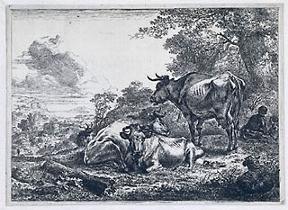 Three cows are resting with two shepherds in the shade of a tree. A sheep is depicted in the bottom righthand corner, while a goat appears behind the cows. As in many of these Italianate landscapes, the scene is lit by a low, evening sun. In the hazy distance looms the outline of the mountains.
Three cows are resting with two shepherds in the shade of a tree. A sheep is depicted in the bottom righthand corner, while a goat appears behind the cows. As in many of these Italianate landscapes, the scene is lit by a low, evening sun. In the hazy distance looms the outline of the mountains.
Perhaps this was a landscape Nicolaes Berchem had seen in Italy. Even so, the picture was not drawn directly from nature. He borrowed two of the cows from a print made by Paulus Potter in 1643. Potter, who specialised in depicting animals, placed his cows in a typically Dutch landscape, while Berchem preferred a more southerly countryside.
Title
Three Resting Cows
Year
c. 1657
Artist
Nicolaes Berchem
Technique
Ink on paper/Etching
Dimensions
17,7 x 24,2 cm
Object number
RP-P-H-1319
History
Born on 01 October 1620: Nicolaes (or Claes) Pieterzoon Berchem (or Berghem) van Haarlem, Dutch painter who died on 18 February 1683. A Dutch painter of pastoral landscapes in the Italianate manner, principally active in Haarlem. He was the son of the still-life painter Pieter Claeszoon Berchem van Haarlem [called Pieter Claesz. in references, as if Claesz was his last name and not, especially with the period after the z which some references maintain, the standard abbreviation for Claeszoon, or son of Claes, which must be short for Nicolaes. Thus this Nicolaes Pieterz. Berchem must be the son of Pieter Claeszoon Berchem, himself the son of grandpa Claes or Nicolaes Berchem]. Pieter’s father was his first teacher, but although Nicolaes Pieterzoon Berchem tried his hand at most subjects, no still-lifes by him are known. He visited Italy in the 1640s and perhaps again in the 1650s and became, with Jan Both, the most highly regarded exponent of the Italianate landscape. Successful and well rewarded in his lifetime, he had numerous students and his influence on 18th century English and French landscape painters was very considerable, Gainsborough and Watteau being among the artists who particularly admired his work.
During the course of his long and extremely prolific career Berchem, the son of Pieter Claeszoon, the outstanding still-life painter, painted biblical, allegorical, and mythological themes, views of harbours, winter scenes, nocturnals, battles, and some genre scenes, as well as the Italianate landscapes for which he is so justly famous, but he apparently never tried his hand at still-life painting.
Berchem’s pictures have a more pronounced pastoral character than Jan Both’s or Asselyn’s. Shepherds and buxom shepherdesses tending their flocks and herdsmen guarding their cattle receive prominent places in his works. His lively figures are seen in sparkling Italian light among ancient ruins, fording rivers, or set against magnificent panoramic views of vast Italian valleys and mountain ranges. The large scale of his figures often suggests his paintings could be classified as pastoral genre scenes as well as landscapes — the same is true of many of Jan Baptist Weenix’s (1621~1663) Italianate paintings. Wisps of white cloud float in Berchem’s dazzling blue skies, and bits of vividly colored clothing worn by herders, milkmaids, and travellers brighten the cool greens of his landscapes. His peasants enjoy a life of innocence and happiness among their animals. It is an idyllic dream world which appealed to a public that found Arcadia a refuge from worldly cares and responsibility. The mood of his pictures justifies the claim that Berchem, who died in I683, the year Watteau was born, is one of the precursors of the Rococo. Berchem’s success stimulated a number of close followers. Karel Dujardin [1622~1678] was his student. The genre painters Pieter de Hooch (1629~1684) and Jacob Ochtervelt, artists who soon went their own way, also studied under him.
Nicolaes Berchem, the son of a distinguished still-life painter, Pieter Claeszoon, was born in Haarlem. The town was a leading centre of landscape painting in the early seventeenth century and among Berchem’s teachers was the landscapist Jan van Goyen. Like many Dutch artists, Berchem travelled to Italy immediately after completing his apprenticeship. He was in Rome late in 1642 and remained there for three years. While in Italy, Berchem made many drawings of the landscape of the Roman Campagna, its cattle and peasants. On his return to Haarlem, Berchem quarried this rich material throughout a long and extremely productive career, painting (and etching) hundreds of Italianate pastoral scenes. As is evident from this painting, he interpreted the Italian landscape and the life of its peasants in an idyllic manner, emphasizing its timeless continuity by the inclusion of antique monuments. These buildings cannot be identified, as they are only loosely modelled on actual ruins. Berchem uses a bright, highly-colored palette and applies the paint in short, stabbing brush strokes. In seventeenth-century Holland there was a constant demand for exotic landscapes of this type and Berchem was a highly successful artist. He moved to Amsterdam, which had a larger art market than Haarlem, in about 1677. His work was widely imitated and copied during his lifetime and his paintings enthusiastically sought after in France in the eighteenth century and in England in the nineteenth.






























